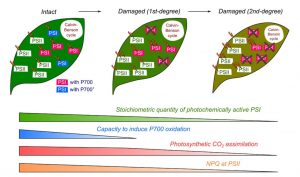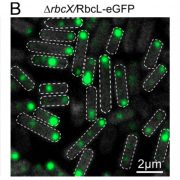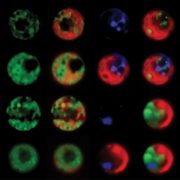What quantity of photosystem I is optimum for safe photosynthesis? ($) (Plant Physiol)
 Photosynthesis is one of the most vital and complex processes carried out by plants. During photosynthesis, Photosystem I and II (PSI and PSII) undergo photo-excitation. Excessive photo-excitation can damage and deactivate the PSI by generating reactive oxygen species (ROS). This kind of photoinhibition of PSI is a lethal event that can abruptly inhibit the photosynthesis and growth of oxygenic photoautotrophs. However, photoinhibition of PSI in plants does not occur regularly as plants control it by maintaining the PSI at its oxidative state. Observations from different studies suggest that the optimized quantity of PSI can induce protection against photoinhibition and ensure robust photosynthesis. Shimakawa and Miyake characterized the effects of photochemically active and inactivated PSI on a variety of photosynthetic parameters such as oxidation of P700, photosynthetic CO2 assimilation, and interrelation of PSI and PSII, using intact leaves of the Arabidopsis thaliana. The active and inactivated state of PSI was maintained by using repetitive short pulse (rSP) illumination. They observed that there is a linear correlation between PSI activity and P700 oxidation and CO2 assimilation for a range of 100% to 60% of PSI activity. (Summary by Mugdha Sabale) Plant Physiol. 10.1104/pp.18.01493
Photosynthesis is one of the most vital and complex processes carried out by plants. During photosynthesis, Photosystem I and II (PSI and PSII) undergo photo-excitation. Excessive photo-excitation can damage and deactivate the PSI by generating reactive oxygen species (ROS). This kind of photoinhibition of PSI is a lethal event that can abruptly inhibit the photosynthesis and growth of oxygenic photoautotrophs. However, photoinhibition of PSI in plants does not occur regularly as plants control it by maintaining the PSI at its oxidative state. Observations from different studies suggest that the optimized quantity of PSI can induce protection against photoinhibition and ensure robust photosynthesis. Shimakawa and Miyake characterized the effects of photochemically active and inactivated PSI on a variety of photosynthetic parameters such as oxidation of P700, photosynthetic CO2 assimilation, and interrelation of PSI and PSII, using intact leaves of the Arabidopsis thaliana. The active and inactivated state of PSI was maintained by using repetitive short pulse (rSP) illumination. They observed that there is a linear correlation between PSI activity and P700 oxidation and CO2 assimilation for a range of 100% to 60% of PSI activity. (Summary by Mugdha Sabale) Plant Physiol. 10.1104/pp.18.01493









